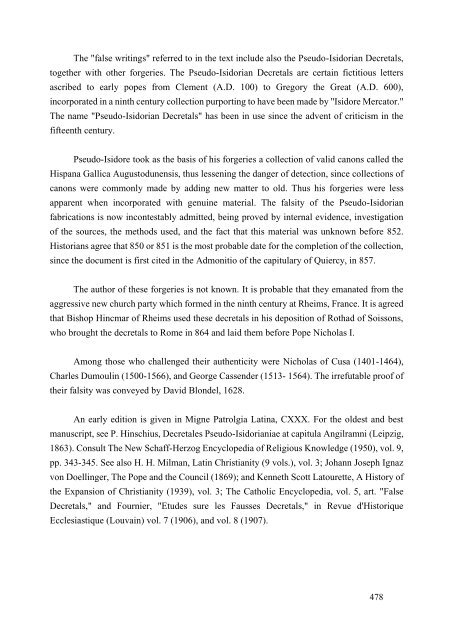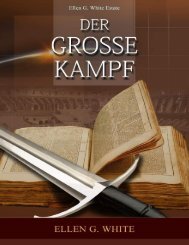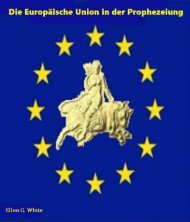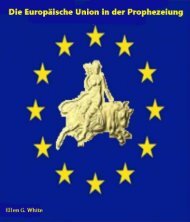- Page 2 and 3:
Information about this Book Overvie
- Page 4 and 5:
Table of Contents Information about
- Page 6 and 7:
1. World History Predicted "If thou
- Page 8 and 9:
vineyard," He exclaims, "that I hav
- Page 10 and 11:
in heaven and earth. The precepts o
- Page 12 and 13:
not then fully understood; but thei
- Page 14 and 15:
controlled by impulse and blind rag
- Page 16 and 17:
Terrible were the calamities that f
- Page 18 and 19:
torch between the hinges of the doo
- Page 20 and 21:
will come the second time to gather
- Page 22 and 23:
thousands. Beneath the hills outsid
- Page 24 and 25:
to the Pattern, the other class shu
- Page 26 and 27:
How, then, can the gospel be called
- Page 28 and 29:
3. An Era of Darkness The apostle P
- Page 30 and 31:
sacrilegious work, Rome presumed to
- Page 32 and 33:
prepared of God, that they should f
- Page 34 and 35:
without his guards, into an outer c
- Page 36 and 37:
committing adultery, they break out
- Page 38 and 39:
island of Iona, made this the cente
- Page 40 and 41:
up to resist her corruptions. While
- Page 42 and 43:
otherly love. In times of peace the
- Page 44 and 45:
where they would have been spurned
- Page 46 and 47:
Saviour's love seemed too much for
- Page 48 and 49:
might have taken; it legitimatized
- Page 50 and 51:
cause of reform by exposing the ign
- Page 52 and 53:
of the nation. And while spending t
- Page 54 and 55:
war upon the other, enforcing his d
- Page 56 and 57:
was at this time no law in England
- Page 58 and 59:
Thus Wycliffe presented to the pope
- Page 60 and 61:
as best they could in the humble ho
- Page 62 and 63:
At the university, Huss soon distin
- Page 64 and 65:
themselves eternal condemnation, an
- Page 66 and 67:
as well as the leading propagator o
- Page 68 and 69:
and kings."--Jacques Lenfant, Histo
- Page 70 and 71:
persecutors vainly imagined that th
- Page 72 and 73:
suffering and mental anxiety. Yet h
- Page 74 and 75:
The murderers of Huss did not stand
- Page 76 and 77:
now, after reigning one year, he di
- Page 78 and 79:
practical character of his mind led
- Page 80 and 81:
Luther was still a true son of the
- Page 82 and 83:
The official appointed to conduct t
- Page 84 and 85:
that the gospel of Christ is the mo
- Page 86 and 87:
however, who had received from Luth
- Page 88 and 89:
truth, his readiness to answer all
- Page 90 and 91:
secure this object, and he secretly
- Page 92 and 93:
When the papal bull reached Luther,
- Page 94 and 95:
8. Tried Before the Council A new e
- Page 96 and 97:
there is enough," he declared, to w
- Page 98 and 99:
error. I despise them during my lif
- Page 100 and 101:
have long consulted on this matter.
- Page 102 and 103:
e with him. In anguish of spirit he
- Page 104 and 105:
Luther had spoken in German; he was
- Page 106 and 107:
His words were not without effect.
- Page 108 and 109:
conceal their sympathy with Luther.
- Page 110 and 111:
knew not whither he had been conduc
- Page 112 and 113:
9. Reform in Switzerland In the cho
- Page 114 and 115:
salvation and grace, comforts it in
- Page 116 and 117:
understanding by constant and earne
- Page 118 and 119:
the subjects upon which he dwelt. "
- Page 120 and 121:
Thus Zwingli maintained the battle
- Page 122 and 123:
of the Reformation--that the word o
- Page 124 and 125:
violence. I will not make use of fo
- Page 126 and 127:
the rebellion was the legitimate fr
- Page 128 and 129:
upon its subjects an iron yoke whic
- Page 130 and 131:
11. Princely Protest One of the nob
- Page 132 and 133:
eadily be found for "completing the
- Page 134 and 135:
of the emperor and the pope was str
- Page 136 and 137:
pressing him to cross the river. Th
- Page 138 and 139:
of the empire. Kings and great men
- Page 140 and 141:
12. The French Reformation The Prot
- Page 142 and 143:
Farel joyfully accepted the truth.
- Page 144 and 145:
But as dangers thickened, Berquin's
- Page 146 and 147:
As in apostolic days, persecution h
- Page 148 and 149:
schoolmen. The minds of men were st
- Page 150 and 151:
By some secret hand--whether of ind
- Page 152 and 153:
publicly give his sanction to the d
- Page 154 and 155:
unfolded to men the statutes and pr
- Page 156 and 157:
In this visit Farel recognized the
- Page 158 and 159:
For nearly thirty years Calvin labo
- Page 160 and 161:
conscience; but without avail. Afte
- Page 162 and 163:
to Wittenberg. The scholar of the c
- Page 164 and 165:
As the result of this disputation t
- Page 166 and 167:
truth. "One holdeth this doctor, an
- Page 168 and 169:
In Scotland the seeds of truth scat
- Page 170 and 171:
eligious meetings except such as we
- Page 172 and 173:
Saviour had done more for them. And
- Page 174 and 175:
learned meekness in the school of C
- Page 176 and 177:
that a believer is freed from the "
- Page 178 and 179:
away His crown; to set light by any
- Page 180 and 181:
The periods here mentioned--"forty
- Page 182 and 183:
"Who is Jehovah, that I should hear
- Page 184 and 185:
But blackest in the black catalogue
- Page 186 and 187:
"The fool hath said in his heart, T
- Page 188 and 189:
assurance forever." Isaiah 32:17. H
- Page 190 and 191:
indolent, frivolous, and sensual mo
- Page 192 and 193:
that were thrust into dungeons and
- Page 194 and 195:
permitted to work his will. Those w
- Page 196 and 197:
16. The Pilgrim Fathers The English
- Page 198 and 199:
should reveal anything to you by an
- Page 200 and 201:
state and government of the country
- Page 202 and 203:
the present, of attempting to build
- Page 204 and 205:
17. Heralds of the Morning One of t
- Page 206 and 207:
It is then that the peaceful and lo
- Page 208 and 209:
containing eight or ten thousand in
- Page 210 and 211:
53, 54. "In most parts of the count
- Page 212 and 213:
men that are settled on their lees:
- Page 214 and 215:
ambitious strife for place and powe
- Page 216 and 217:
to fail; but they departed from Him
- Page 218 and 219:
grave. The future was dark and gloo
- Page 220 and 221:
days perilous times shall come;" an
- Page 222 and 223:
find the most stupendous event to t
- Page 224 and 225:
the seventy weeks was seen to have
- Page 226 and 227:
"And He shall confirm the covenant
- Page 228 and 229:
And now the duty of making known to
- Page 230 and 231:
admiration by one class in the comm
- Page 232 and 233:
Earnest were the efforts put forth
- Page 234 and 235:
the professed people of God are uni
- Page 236 and 237:
In view of the testimony of Inspira
- Page 238 and 239:
manifest. They "inquired and search
- Page 240 and 241:
of His parables Christ uses the exp
- Page 242 and 243:
powers, nor things present, nor thi
- Page 244 and 245:
Yet God accomplished His own benefi
- Page 246 and 247:
with his caution the whole of the C
- Page 248 and 249:
creation, and forfeited by him (Gen
- Page 250 and 251:
Israel, of the tribe of Dan, . . .
- Page 252 and 253:
As he pursued his investigation of
- Page 254 and 255:
as they entered the gates of Jerusa
- Page 256 and 257:
time of Christ's first advent they
- Page 258 and 259:
were purity of soul--characters cle
- Page 260 and 261:
commented upon by both the press an
- Page 262 and 263:
unity of the Spirit in the bond of
- Page 264 and 265:
maintained despotic sway over the m
- Page 266 and 267:
Has not the same process been repea
- Page 268 and 269:
espectability. They are called to s
- Page 270 and 271:
22. Prophecies Fulfilled When the t
- Page 272 and 273:
Spirit, which renders His word a la
- Page 274 and 275:
movements. . . . Many among us who
- Page 276 and 277:
In like manner the types which rela
- Page 278 and 279:
cometh in the name of the Lord!" Ma
- Page 280 and 281:
The world had been looking on, expe
- Page 282 and 283:
deceived. Give up your faith, and s
- Page 284 and 285:
With this reckoning, all was clear
- Page 286 and 287:
instruments thereof, even so shall
- Page 288 and 289:
He "shall sit and rule upon His thr
- Page 290 and 291:
Once a year, on the great Day of At
- Page 292 and 293:
epentance of sin and faith in Chris
- Page 294 and 295:
This coming is foretold also by the
- Page 296 and 297:
Says the prophet: "Who may abide th
- Page 298 and 299:
Bible for clearer light-these saw t
- Page 300 and 301:
communion with God. To them the doo
- Page 302 and 303:
25. God's Law The temple of God was
- Page 304 and 305:
1844 must continue until the cases
- Page 306 and 307:
upon Christ and His people during t
- Page 308 and 309:
hope. Millions have sought its shor
- Page 310 and 311:
The wide diversity of belief in the
- Page 312 and 313:
called the least in the kingdom of
- Page 314 and 315:
In the issue of the contest all Chr
- Page 316 and 317:
Isaiah 58:1, 2. Here is brought to
- Page 318 and 319:
against the simple, straightforward
- Page 320 and 321:
so long delayed and His people shou
- Page 322 and 323:
27. Revival Wherever the word of Go
- Page 324 and 325:
Notwithstanding the widespread decl
- Page 326 and 327:
The law of God, from its very natur
- Page 328 and 329:
This work can be accomplished only
- Page 330 and 331:
and keepeth not His commandments, i
- Page 332 and 333:
The world is given up to self-indul
- Page 334 and 335:
"Blessed is the man that walketh no
- Page 336 and 337:
a later period. "Judgment must begi
- Page 338 and 339:
All who have truly repented of sin,
- Page 340 and 341:
not been repented of and forsaken w
- Page 342 and 343:
after His resurrection He ascended
- Page 344 and 345:
29. Why So Much Suffering? To many
- Page 346 and 347:
only aroused a spirit of resistance
- Page 348 and 349:
concealed his work under a specious
- Page 350 and 351:
for thousands, forgiving iniquity a
- Page 352 and 353:
In the final execution of the judgm
- Page 354 and 355:
The antagonism that exists between
- Page 356 and 357:
which appears like courtesy or refi
- Page 358 and 359:
31. Evil Spirits The connection of
- Page 360 and 361:
edemption, and Satan determined to
- Page 362 and 363:
and half human. He is pleased to he
- Page 364 and 365:
ethren are not few, and they are al
- Page 366 and 367:
Human knowledge of both material an
- Page 368 and 369:
Himself does nothing contrary to th
- Page 370 and 371:
them do every duty which has been m
- Page 372 and 373:
33. First Great Deception With the
- Page 374 and 375:
But after the Fall, Satan bade his
- Page 376 and 377:
accept false doctrines because our
- Page 378 and 379:
liss of the eternal world. God has
- Page 380 and 381:
Could those whose lives have been s
- Page 382 and 383:
the lives of the friends whom they
- Page 384 and 385:
Before any can enter the mansions o
- Page 386 and 387:
34. Can Our Dead Speak to Us? The m
- Page 388 and 389:
devilish." James 3:15. This, howeve
- Page 390 and 391:
By representing the basest of men a
- Page 392 and 393:
sympathies and will work miracles t
- Page 394 and 395:
35. Liberty of Conscience Threatene
- Page 396 and 397:
of the Catholics. These things shou
- Page 398 and 399:
Matthew 11:28. It is Satan's consta
- Page 400 and 401:
As the Protestants churches have be
- Page 402 and 403:
As the papacy became firmly establi
- Page 404 and 405:
A striking illustration of Rome's p
- Page 406 and 407:
oath pledging their loyalty to the
- Page 408 and 409:
place of Jehovah; while the living
- Page 410 and 411:
The iniquity and spiritual darkness
- Page 412 and 413:
Satan works through the elements al
- Page 414 and 415:
upon their motives. As the Protesta
- Page 416 and 417:
midst of heaven, He requires every
- Page 418 and 419:
conjugal, or social, the effect is
- Page 420 and 421:
emembrance, whatsoever I have said
- Page 422 and 423:
38. The Final Warning "I saw anothe
- Page 424 and 425:
event so long doubted and disbeliev
- Page 426 and 427:
them. They have not consulted their
- Page 428 and 429:
therefore, and be converted, that y
- Page 430 and 431: power exercised by holy angels when
- Page 432 and 433: perseverance, are here displayed! H
- Page 434 and 435: Satan leads many to believe that Go
- Page 436 and 437: 14:30. Satan could find nothing in
- Page 438 and 439: their destruction, the people of Go
- Page 440 and 441: These plagues are not universal, or
- Page 442 and 443: as guides to benighted travelers. T
- Page 444 and 445: chambers, and shut thy doors about
- Page 446 and 447: It is at midnight that God manifest
- Page 448 and 449: all can read them. Memory is arouse
- Page 450 and 451: stand?" The wicked pray to be burie
- Page 452 and 453: wonderful redemption! long talked o
- Page 454 and 455: edeemed, standing in the Paradise o
- Page 456 and 457: not be fully understood, even when
- Page 458 and 459: The world see the very class whom t
- Page 460 and 461: At the coming of Christ the wicked
- Page 462 and 463: For a thousand years, Satan will wa
- Page 464 and 465: 42. Controversy Ended At the close
- Page 466 and 467: Now Christ again appears to the vie
- Page 468 and 469: Amid the ransomed throng are the ap
- Page 470 and 471: ows down and confesses the justice
- Page 472 and 473: Satan's work of ruin is forever end
- Page 474 and 475: precious, even like a jasper stone,
- Page 476 and 477: Appendix General Notes for the Grea
- Page 478 and 479: Page 53. The Sunday Law of Constant
- Page 482 and 483: On the practical outworkings of the
- Page 484 and 485: For a summary of these bulls sent t
- Page 486 and 487: Page 265. Causes of the French Revo
- Page 488 and 489: Page 283. Retribution.--For further
- Page 490 and 491: Eastern Roman Empire. Throughout th
- Page 492 and 493: with presumptuous folly who reveren

















